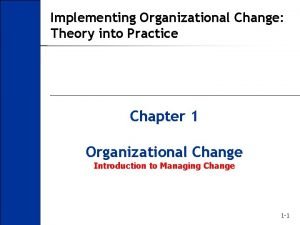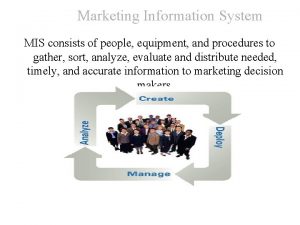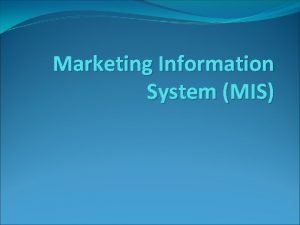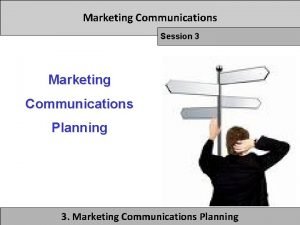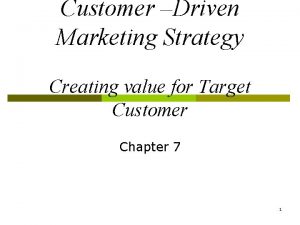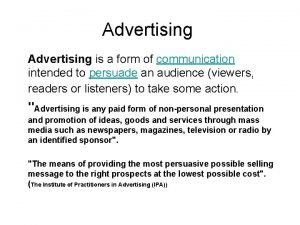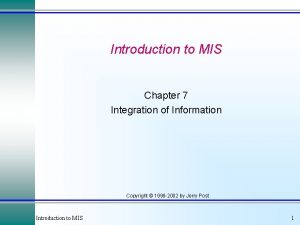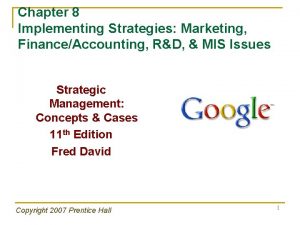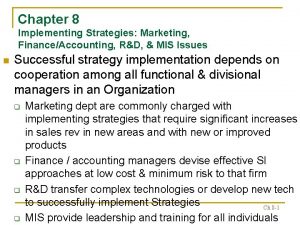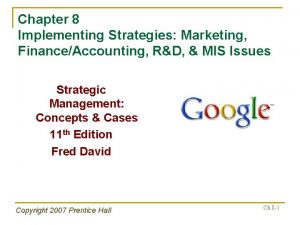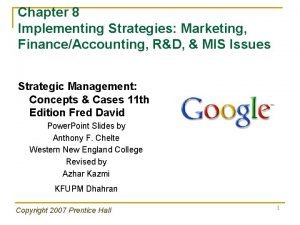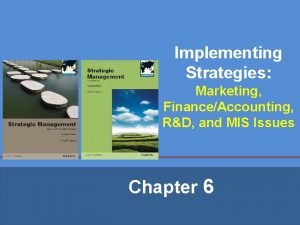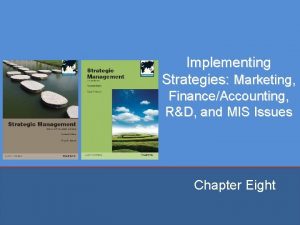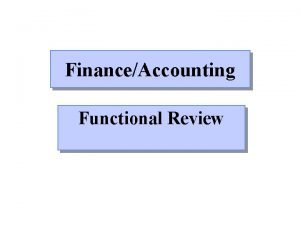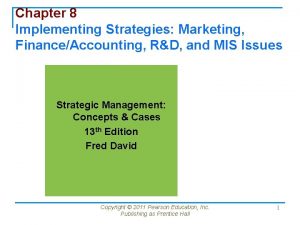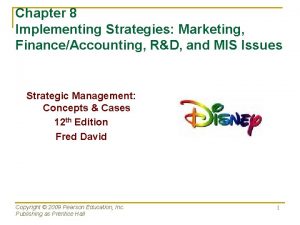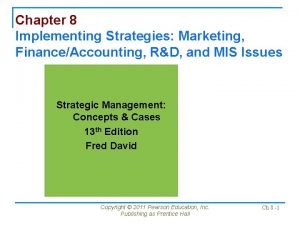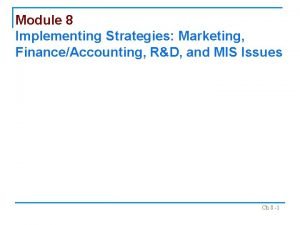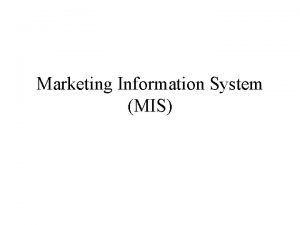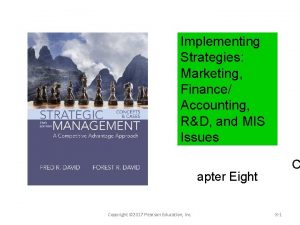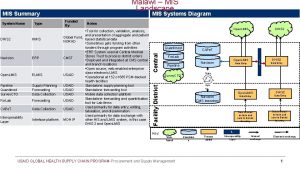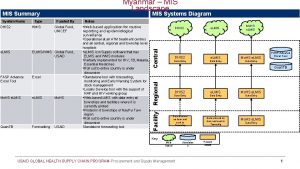Chapter 8 Implementing Strategies Marketing FinanceAccounting RD MIS





















































- Slides: 53

Chapter 8 Implementing Strategies: Marketing, Finance/Accounting, R&D, & MIS Issues Strategic Management: Concepts & Cases 11 th Edition Fred David Copyright 2007 Prentice Hall 1

Chapter Outline The Nature of Strategy Implementation Marketing Issues Finance/Accounting Issues Copyright 2007 Prentice Hall 2

Chapter Outline (cont’d) Research & Development (R&D) Issues Management Information Systems (MIS) Issues Copyright 2007 Prentice Hall 3

Implementing Strategies The greatest strategy is doomed if it’s implemented badly. -Bernard Reimann Copyright 2007 Prentice Hall 4

The Nature of Strategy Implementation -- Strategy implementation means change Copyright 2007 Prentice Hall 5

The Nature of Strategy Implementation -- Less than 10% of strategies formulated are successfully implemented! Copyright 2007 Prentice Hall 6

The Nature of Strategy Implementation Low Success Rate – Strategy Implementation n n Failing to segment markets appropriately Paying too much for a new acquisition Falling behind competition in R&D Not recognizing benefit of computers in managing information Copyright 2007 Prentice Hall 7

The Nature of Strategy Implementation Successful Strategy Implementation n n Market goods & services well Raise needed working capital Produce technologically sound goods Sound information systems Copyright 2007 Prentice Hall 8

Marketing Issues -- Marketing variables affect success/failure of strategy implementation Copyright 2007 Prentice Hall 9

Marketing Issues Marketing decisions requiring policies n n n Exclusive dealerships – multiple channels of distribution Heavy, light, or no TV advertising Price leader or price follower Advertise online or not Offer complete or limited warranty Copyright 2007 Prentice Hall 10

Marketing Issues Centrally important to Implementation 1. Market segmentation 2. Product positioning Copyright 2007 Prentice Hall 11

Marketing Issues Market Segmentation n Subdividing of a market into distinct subsets of customers according to needs and buying habits Copyright 2007 Prentice Hall 12

Marketing Issues Market Segmentation n n Key to matching supply & demand Market development, product-development, market penetration & diversification strategies Allows operating with limited resources Enables small firms to compete successfully Copyright 2007 Prentice Hall 13

Marketing Issues Market Segmentation n Directly affect marketing mix variables: q q Product Place Promotion Price Copyright 2007 Prentice Hall 14

Marketing Mix – Component Factors Product Place Promotion Price Quality Distribution channels Advertising Level Features Distribution coverage Personal selling Discounts & allowances Style Outlet location Sales promotion Payment terms Brand name Sales territories Publicity Packaging Inventory levels/locations Product line Transportation carriers Warranty Service level 15

Marketing Issues Geographic Demographic Market Segment Basis Psychographic Behavioral Copyright 2007 Prentice Hall 16

Marketing Issues Geographic n n n Region County size City or SMSA size Density Climate Copyright 2007 Prentice Hall 17

Marketing Issues Geographic Demographic Market Segment Basis Psychographic Behavioral Copyright 2007 Prentice Hall 18

Marketing Issues Demographic n n n n Age Family Size Family Life Cycle Income/Occupation Education Religion Race/Nationality Copyright 2007 Prentice Hall 19

Marketing Issues Geographic Demographic Market Segment Basis Psychographic Behavioral Copyright 2007 Prentice Hall 20

Marketing Issues Psychographic n n n Social Class Lifestyle Personality Copyright 2007 Prentice Hall 21

Marketing Issues Geographic Demographic Market Segment Basis Psychographic Behavioral Copyright 2007 Prentice Hall 22

Marketing Issues Behavioral n n n n Use occasion Benefits sought User status Usage rate Loyalty status Readiness stage Attitude toward product Copyright 2007 Prentice Hall 23

Marketing Issues Product Positioning -- Schematic representations that reflect how products/services compare to competitors’ on dimensions most important to success in the industry Copyright 2007 Prentice Hall 24

Marketing Issues Customer Wants Product Positioning Customer Needs Copyright 2007 Prentice Hall 25

Product Positioning Steps 1. Select Key Criteria 2. Diagram Map Product Positioning Steps 3. Plot competitors’ 4. products 4. Look for niches 5. Develop Marketing Plan Copyright 2007 Prentice Hall 26

Product Positioning Map High Convenience Rental Car Market • Firm 2 Firm 1 • High Customer Loyalty Low Customer Loyalty • Firm 3 Low Convenience Copyright 2007 Prentice Hall 27

Marketing Issues Product Positioning as Strategy Implementation Tool n n Look for vacant niche Avoid sub optimization Do’s serve 2 segments w/ same strategy Don’ts position in the middle of the map Copyright 2007 Prentice Hall 28

Finance/Accounting Issues -- Central to strategy implementation Copyright 2007 Prentice Hall 29

Finance/Accounting Issues Essential for implementation n n Acquiring needed capital Developing projected financial statements Preparing financial budgets Evaluating worth of a business Copyright 2007 Prentice Hall 30

Finance/Accounting Issues Decisions based on Finance/Accounting n n n Raise capital – short-term, long-term, preferred, or common stock Lease or buy fixed assets Determine appropriate dividend payout ratio Copyright 2007 Prentice Hall 31

Finance/Accounting Issues Decisions based on Finance/Accounting n n LIFO, FIFO, or market-value accounting approach Extend time of AR Establish % discount on accounts for terms Determine the amount of cash kept on hand Copyright 2007 Prentice Hall 32

Finance/Accounting Issues Capital acquisition to implement strategies n Debt n Equity Copyright 2007 Prentice Hall 33

Finance/Accounting Issues Debt vs. Equity Decisions n EPS/EBIT analysis q Earnings per share/Earnings before interest and taxes Copyright 2007 Prentice Hall 34

Copyright 2007 Prentice Hall 35

Copyright 2007 Prentice Hall 36

Finance/Accounting Issues Projected Financial Statements n Allow an organization to examine the expected results of various actions and approaches Copyright 2007 Prentice Hall 37

Finance/Accounting Issues Steps in Preparing Projected Financial Statements 1. Prepare income statement before balance sheet (forecast sales) 2. Use percentage of sales method to project Co. GS & expenses 3. Calculate projected net income Copyright 2007 Prentice Hall 38

Finance/Accounting Issues Steps in Preparing Projected Financial Statements (cont’d) 4. Subtract dividends to be paid from Net Income and add remaining to Retained Earnings 5. Project balance sheet times beginning with retained earnings 6. List comments (remarks) on projected statements Copyright 2007 Prentice Hall 39

Projected Income Statement for Litten Company (in millions) Prior Year 2005 Projected Year 2006 Remarks Projected Income Statement Sales 100 150. 00 50% increase 70 105. 00 70% of sales 30 45. 00 10 15. 00 10% of sales 5 7. 50 5% of sales 15 22. 50 3 3. 00 12 19. 50 Taxes 6 9. 75 Net Income 6 9. 75 2 5. 00 4 4. 75 Cost of Goods Sold Gross Margin Selling Expense Administrative Expense EBIT Interest EBT Dividends Retained Earnings Copyright 2007 Prentice Hall 50% rate 40

Finance/Accounting Issues Financial Budget -- Details how funds will be obtained and spent for a specified period of time. Copyright 2007 Prentice Hall 41

Finance/Accounting Issues Types of Budgets n n n Cash budgets Operating budgets Sales budgets Profit budgets Factory Budgets Expense Budgets Copyright 2007 Prentice Hall 42

Finance/Accounting Issues Types of Budgets n n Divisional budgets Variable budgets Flexible budgets Fixed budgets Copyright 2007 Prentice Hall 43

Finance/Accounting Issues Evaluating Worth of a Business n Central to strategy implementation – integrative, intensive, & diversification strategies often implemented through acquisitions of other firms Copyright 2007 Prentice Hall 44

Finance/Accounting Issues Evaluating Worth of a Business: 3 Basic Approaches 1. 2. 3. What a firm owns What a firm earns What a firm will bring in the market Copyright 2007 Prentice Hall 45

Worth of a Business Analysis Southwest Airlines Stockholders’ Equity: Net Income: Stock Price: EPS: Shares Outstanding Company Worth Analysis Stockholders Equity Net Income x 5 Share Price/EPS x NI # Shares x Share Price Copyright 2007 Prentice Hall $ 5, 524 313 15. 70. 45 784 $ 5, 524 1, 565 10, 920 12, 309 46

Research & Development Issues -- New products and improvement of existing products that allow for effective strategy implementation Copyright 2007 Prentice Hall 47

Research & Development Issues Constraints n n Level of support constrained by resource availability Technological improvements shorten product life cycles Copyright 2007 Prentice Hall 48

Research & Development Issues 3 Major R&D approaches to implementing strategies 1. 2. 3. 1 st firm to market new technological products Innovative imitator of successful products Low-cost producer of similar but less expensive products Copyright 2007 Prentice Hall 49

Management Information Systems (MIS) Issues -- Information is the basis for understanding the firm. One of the most important factors differentiating successful from unsuccessful firms Copyright 2007 Prentice Hall 50

MIS Issues Functions of MIS n n Information collection, retrieval, & storage Keeping managers informed Coordination of activities among divisions Allow firm to reduce costs Copyright 2007 Prentice Hall 51

For Review (Chapter 8) Key Terms & Concepts Cash Budget Marketing Mix Variables EPS/EBIT Analysis Outstanding Shares Method Management Information Systems (MIS) Price-Earnings Ratio Method Market Segmentation Product Positioning Copyright 2007 Prentice Hall 52

For Review (Chapter 8) Key Terms & Concepts Projected Financial Statement Analysis Research & Development (R&D) Vacant Niche Copyright 2007 Prentice Hall 53
 Implementing strategies marketing finance/accounting
Implementing strategies marketing finance/accounting Management issues central to strategy implementation
Management issues central to strategy implementation Implementing strategies management and operations issues
Implementing strategies management and operations issues Implementing strategies: management and operations issues
Implementing strategies: management and operations issues Designing and implementing brand strategies
Designing and implementing brand strategies Brand hierarchy levels
Brand hierarchy levels Implementing strategies management and operations issues
Implementing strategies management and operations issues Nivea brand architecture
Nivea brand architecture Implementing strategies management and operations issues
Implementing strategies management and operations issues The marketing plan the central instrument
The marketing plan the central instrument Ilumination
Ilumination Mi mision proyecto de vida
Mi mision proyecto de vida Mis tios que son de mis hijos
Mis tios que son de mis hijos Mis mai a mis tachwedd
Mis mai a mis tachwedd Mis mai a mis tachwedd
Mis mai a mis tachwedd Cuales son mis creencias
Cuales son mis creencias Hrd program implementation and evaluation
Hrd program implementation and evaluation The pricing tripod
The pricing tripod Retail management notes doc
Retail management notes doc Characteristics of portfolio assessment
Characteristics of portfolio assessment Crm project design and planning process
Crm project design and planning process Qsen teamwork and collaboration examples
Qsen teamwork and collaboration examples Challenges of implementing predictive analytics
Challenges of implementing predictive analytics Implementing organizational change spector
Implementing organizational change spector Is the traditional method of implementing access control
Is the traditional method of implementing access control Scoring model for project selection
Scoring model for project selection Nfpa 1600 standard
Nfpa 1600 standard Implementing organizational change theory into practice
Implementing organizational change theory into practice Ubmta signatories
Ubmta signatories Nfpa business continuity
Nfpa business continuity Implementing firewall technologies
Implementing firewall technologies Marketing information system questions
Marketing information system questions Define marketing information management
Define marketing information management Introduction to mis
Introduction to mis Push pull profile strategies marketing communications
Push pull profile strategies marketing communications Creative strategies in social media marketing
Creative strategies in social media marketing Target marketing strategies
Target marketing strategies Marketing objectives examples
Marketing objectives examples International product marketing
International product marketing Customer value driven marketing strategy
Customer value driven marketing strategy Smarrtt
Smarrtt Materi developing marketing strategies and plans
Materi developing marketing strategies and plans Starbucks pricing strategy
Starbucks pricing strategy Hospice marketing strategies
Hospice marketing strategies Cold storage advertisement
Cold storage advertisement Internal information search
Internal information search Beef cattle marketing strategies
Beef cattle marketing strategies Apponix technologies complaints
Apponix technologies complaints Marketing strategies for emerging markets
Marketing strategies for emerging markets Gap marketing strategies
Gap marketing strategies Pricing tripod in service marketing
Pricing tripod in service marketing Pricing strategies in marketing
Pricing strategies in marketing Mis chapter 4
Mis chapter 4 Sharepoint 2001
Sharepoint 2001



























